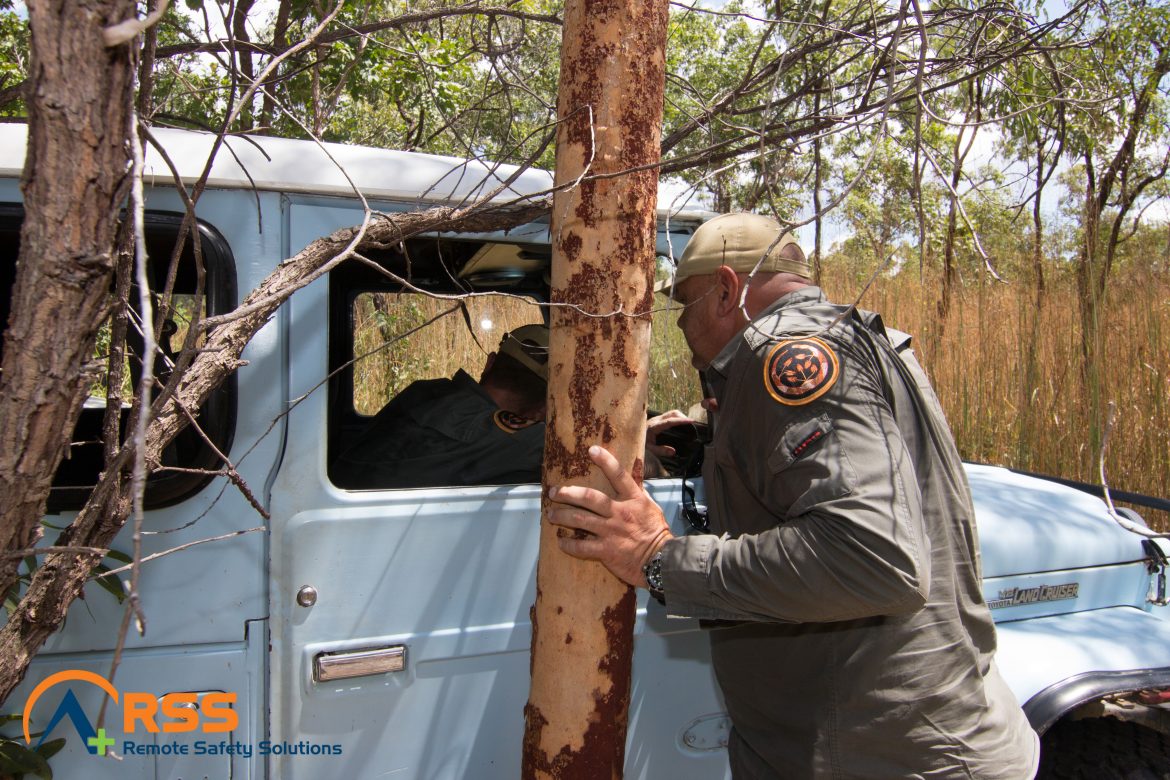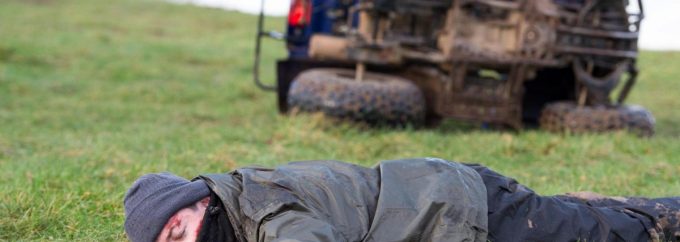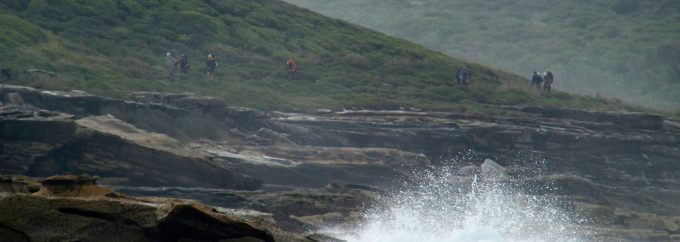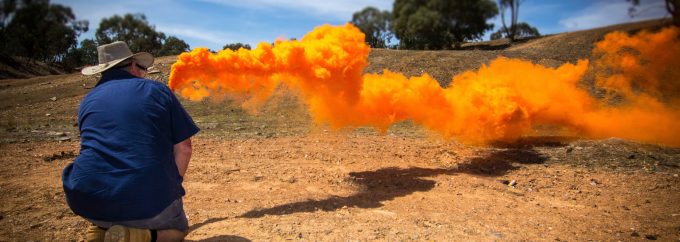On a recent work trip, we found ourselves faced with a number of river crossings which required us to navigate for event medical and safety purposes. The area of operation is well known to the RSS team as we have been working in the area for a number of years and with most crossing, no more than 12 inches deep its was normally a straight forward job getting around. Leading up to the program there had been a number of heavy rain events in the area and from this, waters levels had risen due to a large amount of natural rain runoff which was still draining into the system. Water levels during this period were elevated an extra 12-16 inches, now totaling and around 24-35 inches deep but still well within the vehicle’s ability we elected at the team briefing in the morning to walk all the crossings before taking any vehicles and trailers across. This was mainly to check for any logs snagged in the middle or changes to the bottom that could not be seen. Due to the rain runoff, the water was not the usual crystal clear clarity that we were accustomed too, instead, clarity was down to only around to 20inchs.
Day one was without issues except for having to winch RSS-1 out off 3 creek exits due to being steep and it was towing our 2-tonne gear trailer, the all-terrains just couldn’t get enough traction on the wet slippery exists. Going into Day 2, we had a good morning but it all changed late in the afternoon. Around 2 pm I noted the water color and clarity had changed and flow had increased but the river height hadn’t risen. Around 430pm I needed to move my staff around and as I packing gear into the back of RSS 1 I was thinking about the 7 crossings I had in front of me, just then the hairs on the back of my hands stood up my gut was telling me that something was about to happen. I laughed it off with the team and headed off. I had only crossed the first crossing 10 minutes before with no issues, with no change to the height on the bank and with the depth being only 20inch, and as I had already crossed it 7 times throughout the day I elected just to drive straight in.
That’s when it all went pear shape!
The crossing was made up of a fairly straightforward entry with you crossing the creek at 45 degrees to the exit on the other side. The direction I was crossing was into the flow, this hadn’t been an issue all day as it was only 20inchs deep. The big thing to note about the crossing was that it made by a massive tree that had fallen across the creek years ago and had created a natural causeway.
Once the vehicle entered the water I knew withing seconds that something wasn’t right as water plowed over the bonnet of the patrol and up the windscreen, I felt the rear of the patrol lift and knew we were floating so turned the car into the flow to limit it hitting the side of the vehicle increasing its broadside exposure. Once the nose came around I felt a large bang and the vehicle stopped! I tried to go back, nothing and forward again nothing, yep I was stuck. The patrol was filling quickly so made a distress call on the company radio channel, Grabbed the emergency comms box which was strapped into the seat next to me a crawled out the passenger window and jumped into the water,
to my surprise, the water was up to my stomach. I was in shock thinking what have I done!
The Patrol was still running and the winch gear was ready to go on the front of the vehicle (company SOPs when crossing any body of water) so I jumped it the water and placed the yellow comms box on the bank and ran the which gear out! Once the winch hook was secured to a tree I jumped back in and as I did, kicked the key accidentally killing the engine!!! That’s when I knew I was in real trouble of losing the vehicle which was now full of water up to the seats and still rising. I elected not to try and restart the engine due to the chance of a hydraulic lock of the engine so started to dead drag the patrol out under battery power only. The duel batteries lasted for about 45 seconds allowing me to pull patrols engine about 70% out of the water leaving the rear of the patrol still sitting in deep water. But the vehicle was secure and wasn’t going anywhere for now.
Once back on the bank I radioed to let the team know that I was okay, but RSS 1 wasn’t going anywhere. Earlier during the day I meet a lovely couple camped nearby and they were waiting for some friends to arrive, we said if there were any issues we could contact each other on ch40 so I made a quick call and the came down to have a look and see if they could help. They had some concerns that their 4×4 wouldn’t get the traction and also due to the quickly fading light, we elected to leave the recovery to the morning due to the risks involved.
After a sleepless night, I checked on the patrol and it was a relief to see that the water hadn’t risen overnights. At around 10 am the next day, Steve (the guy camped nearby) generously offered to helped recover RSS 1. It was fairly straightforward recovery and after 3 or so snatches we finally dragged RSS 1 out of the water around 11 am. After a quick look over and drain, I noticed there was no water in the engine oil so decided to attempt a jumped started to see what would happen. Well after a few attempts the patrol coughed up some water and eventually started to run! thank goodness.
A thing to note, during the recovery I noted that RSS 1 had become hung up on a large rock on the bottom and the depth was now over a meter. I couldn’t understand how in 10 minutes the depth had changed but the river height was still the same on the bank. It was doing my head in for a few days after the incident.
A few days later and once back in the RSS office I implemented an internal review of the incident and decided that I would need to head back to the incident site to take a few photos. As soon as I stepped out of the car I noted that the large fallen tree that once created the causeway was now level with the creek height which was creating a natural dam. The water in the creek was flowing underneath it instead of over it. I quickly came to the realized what had happened. With the increase of flow in the afternoon, I suspected that gravel, sand or even other logs under the large fallen tree across the creek had moved allowing water to flow underneath the log at a high volume which washed all the sediment out of the bottom of the creek. This increased the crossing depth without changing the height on the creek bank. The large rock that the patrol had become hung up on was now sitting proudly in the creek. I’m sure it was saying creek 1, patrol 0.
During the review process, it started a great discussion amongst the team and it’s a common question we get asked a lot,
“When is a body of water unsafe to cross? and when Is it Safe to Cross”
Let me start by stating that if its FLOODED then NEVER EVER attempt to cross a body of water, Remember the saying “If it’s flooded, forget it” So I hear you ask, how do I know if a body of water is flooded? Great question. Normally a flooded body of water will be fast flowing and will be muddy in color, white foam on the surface and more than likely be carrying hidden debris, in tight restrictions, there could even be whitewater. I think most people can identify when a body of water is flooded, If do find yourself standing there asking the questions then don’t even attempt it.
So what if it isn’t flooded? The first thing to consider is do I really need to cross here or is there an alternate crossing? I also look to see if I can see the bottom? I ask myself can I stand and is it safe to walk the crossing to determine if there are any objects that can damage the vehicle or worse stop us in the middle? I look downstream and note any terrain or features so if it doesn’t go to plan then I have an escape, recovery or catchment points available. This last point can be a dealer breaker for me. If I look down steam and it narrows and the water flow increases due to it being restricted or if there’s deep water then it’s a no go! Finally, I ask myself is my vehicle capable of this crossing, do I have the right equipment fitted and do I have a system in place if it doesn’t go to plan.
In regards to our safety system there is a number of things you can do, prepare your recovery gear, if possible ensure only the driver is onboard for the crossing and fit appropriate equipment to the vehicle to assist is keeping the water away from sensitive electrical and fuel system.
The most important thing to do is to ensure that our emergency equipment is within arms reach. We use a yellow Pelican case clearly marked with (EMERGENCY) to carry all our emergency equipment. This case consists of a Plb, InReach Sat Communicator, UHF radio (channel EMERG 5), Satellite Phone (112), GPS, Remote Area First aid Kit, Space Blankets, Cyalume Sticks, Fire Lighters, a small tarp, rations, and water. By having this equipment in a self-contained case makes it easy to grab in the event of an emergency. Whether it’s crossing a river in the Vic High Country or traversing the Simpson solo my EMERGENCY Pelican case is always strapped in, sitting on the passenger seat or close by the driver. This is so in the unfortunate event of having an accident occurring such as a collision, rollover, fire or loss of the vehicle the case is within easy arms reach so I can always treat any injuries, insulate the injured and protect myself from the weather while I call for help.
Remember half the fun is getting there, the other half is telling your family and friend about your adventures when you get home, so take the time to plan, prepare and review your adventures.
Have fun and keep it afe, For more information please contact Remote Safety Solutions [email protected]




